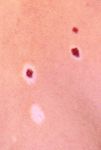Ring around the nevus
An adolescent presents with several moles surrounded by white rings on his back.
All images courtesy of http://www.dermatlas.org/. Vignettes are based on real cases which have been modified to allow the authors and editor to focus on key teaching points. Images may also be edited or substituted for teaching purposes
• What's the diagnosis?• How would you treat him?

Halo nevi were recognized as early as the 16th century, as illustrated by Matthias Grünewald's painting The Temptation of St. Anthony. The nevi were first medically described in 1916 by Richard Lightburn Sutton, who labeled the phenomenon leukoderma acquisitum centrifugum. Since then, the names Sutton nevi and perinevoid vitiligo have also been used. In recent decades, halo nevi have been studied in vivo as a model for regression in melanoma.1
Clinical course
Halo nevi appear as one or more moles with sharply demarcated rings of depigmentation. The halo generally forms around an acquired intradermal nevus, but halos surrounding epidermal, junctional, congenital, and Spitz nevi also have been described.2,3 The onset of the ring of depigmentation is thought to occur over a period of days to weeks. The central pigmented lesion may persist or completely disappear. Repigmentation of the skin can occur over years.
Generally, the diagnosis of halo nevi is based on clinical presentation. However, a retrospective study of 142 patients with halo nevi revealed that 76 cases were diagnosed on histological grounds alone, indicating that a large number of halo nevi may unrecognized.3
Epidemiology
Halo nevi generally affect individuals in the first two decades of life, with a mean age of diagnosis at 15 years and an overall incidence of less than 1%. Men and women are affected equally, with no racial predilection. Evidence points to some individuals experiencing both vitiligo and halo nevi concurrently.4 Both demonstrate a complete absence of melanocytes in the depigmented epidermis and lymphocytic infiltration of the surrounding skin, suggesting a similar immunologic trigger.
Etiology
Although no precipitating factor has been identified, this formation is characterized histologically by mainly CD8+ T lymphocytes. These form a dense band-like lymphocytic infiltrate in the papillary and reticular dermis, with nests of central nevus cells. These CD8+ cells may have a direct cytotoxic affect against melanocytes.5 The presence of antibodies that react with melanocytic cells in vitro in these patients supports a humoral component in the pathogenesis as well.5
Halo nevi and melanoma
A halo around an innocent nevus may lead to the misdiagnosis of melanoma because the inflammatory cells can obscure the architectural features of the underlying nevus.4 Melanomas rarely develop within a halo nevus.
However, the differential diagnosis should include the halo phenomenon. This results in the disappearance of the cutaneous tumor, and eventual superficial fibrosis.6 Regressing melanomas are characterized by asymmetric and patchy areas of hypopigmentation and depigmentation, which appear within and around the melanoma.6
Halo nevi are innocent moles, and should be monitored like other innocent acquired nevi. Only atypical-appearing lesions require biopsy.
In the patient in the vignette, the halos were noted by his mother following a sunburn. The pigmented nevi have similar symmetric features, with uniform borders and texture. The round depigmented macule on the right mid-back probably represents an area of complete regression of a pigmented nevus. A photograph was obtained for baseline documentation, and a follow-up visit was scheduled for one year.
References
1. Musette P, Bachelez H, Flageul B, et al: Immune-mediated destruction of melanocytes in halo nevi is associated with the local expansion of a limited number of T cell clones. J Immunol 1999;162:1789
Recognize & Refer: Hemangiomas in pediatrics
July 17th 2019Contemporary Pediatrics sits down exclusively with Sheila Fallon Friedlander, MD, a professor dermatology and pediatrics, to discuss the one key condition for which she believes community pediatricians should be especially aware-hemangiomas.